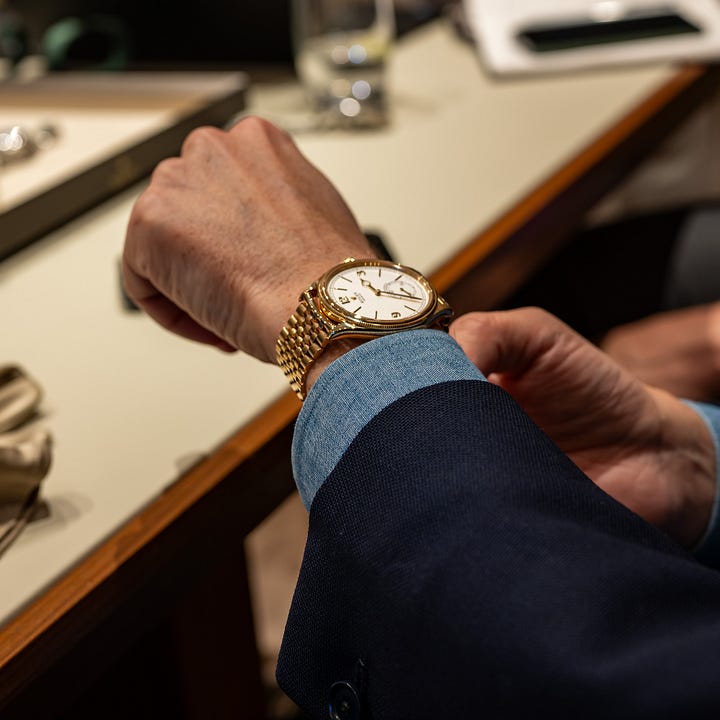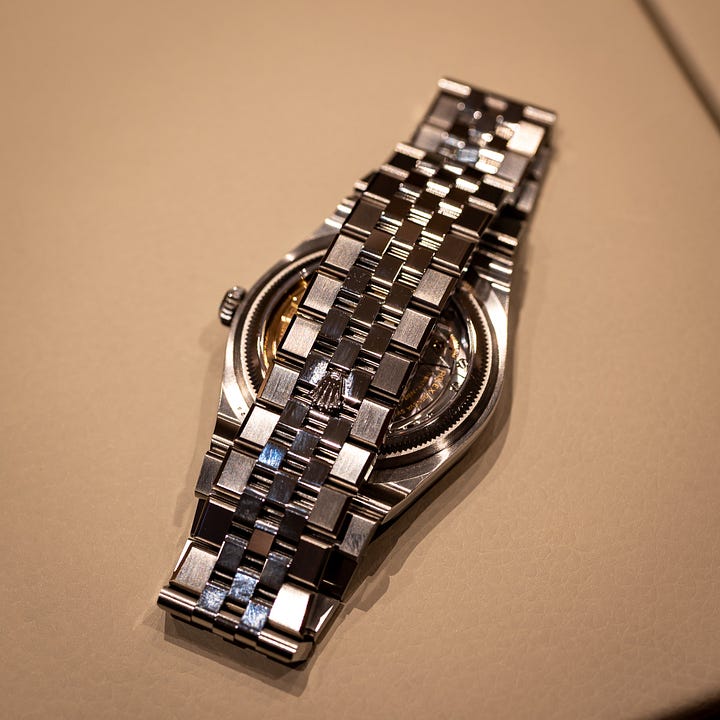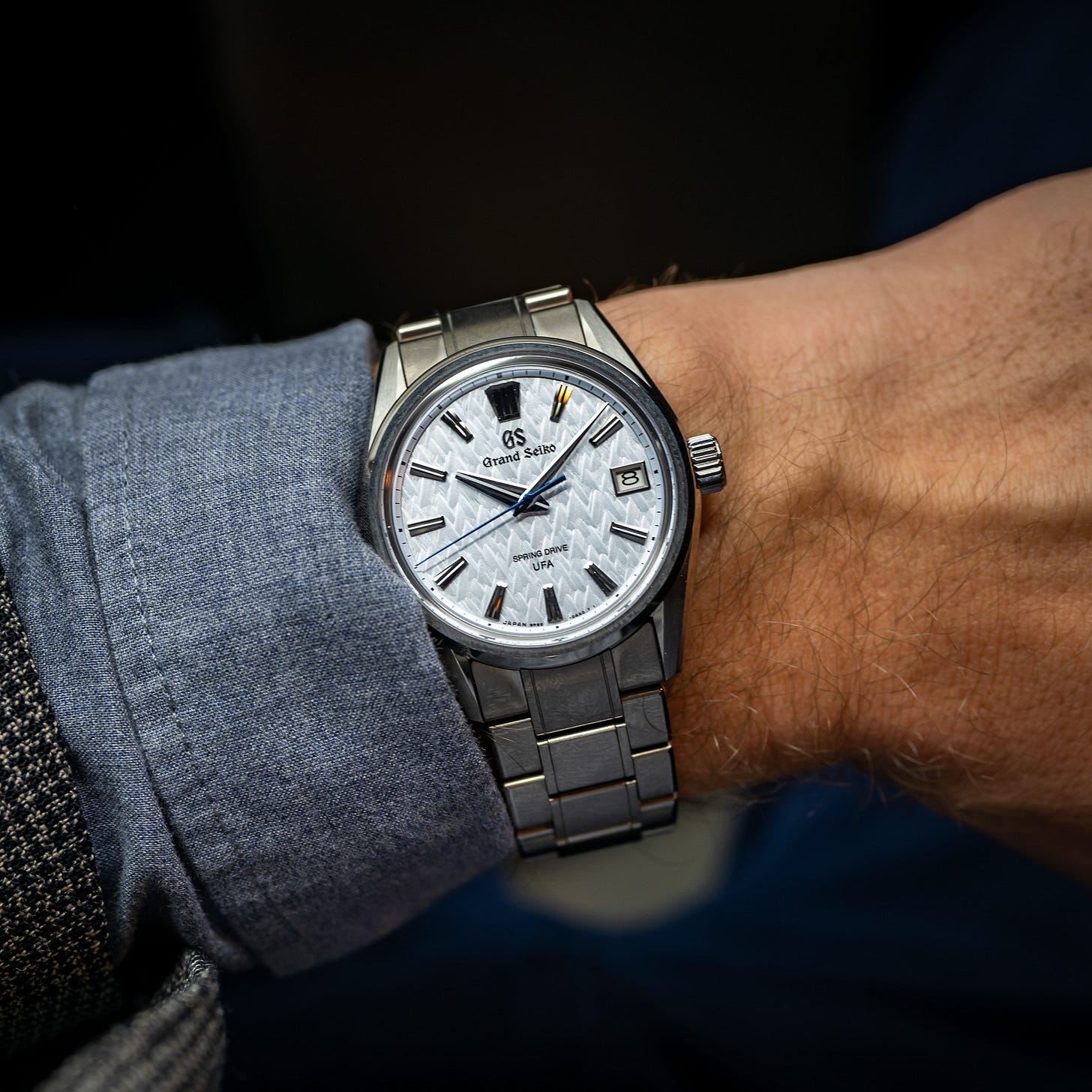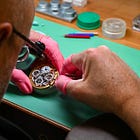10 Half-Baked Thoughts About All Those New Watches (Pt. 1)
From a Michigan retailer to Rolex and silicon, 10 things I like (and don't) about the actual releases from Watches and Wonders 2025.
One morning over breakfast at my hotel in Geneva, I sat across from a retailer based in suburban Michigan. His store carries Omega, Breitling, Tudor—many of the bread-and-butter brands you’d want to carry if you were a retailer in suburban Michigan.1
It was Thursday morning, and he hadn’t heard about the (now-paused) tariffs. When I told him, he shrugged—“we gotta do somethin’.” Politics have crept even into obscure watch fairs, but mostly, we stuck to watches.
That’s because, while Watches & Wonders is a trade show, it’s mostly a product show. In its idealized, 19th-century form, watchmakers would come down to Geneva from their mountainside workshops just as the snow melted to show merchants and clients what they’d been working on for the past year.
My Michigan retailer friend said his business has slowed a bit the past couple of years, but he’s also been lucky because many of his competitors have closed down or lost large brand accounts. We also talked about tendencies and trends.
“People are asking more for small [watches], but they still want big,” he said. He mentioned a group of his good clients—“big guys, probably 300 pounds, a couple of them own car dealerships”—who had already reached out about the new 43mm Tudor Black Bay 68, a watch that’s not getting much love from the media.2
After the first day of Watches and Wonders, I wrote about opulent simplicity, this love child of “quiet luxury,” “geezer watches,” and integrated-bracelet everything. It’s bracelets, smaller, gold-on-gold, rich pastels, a classic luxury reminiscent of a bygone era.
Tudor’s releases seemed to contradict that, quite literally bigger and Ultra-er. That said, Tudor has pushed the Black Bay 58 in a direction that feels like it’s trying for opulent simplicity, as I’ll explore.
Today, we’re getting into the weeds of the actual watches. I’ve got 10 random observations about the new releases from Watches and Wonders. Due to length, this is Part 1, and Part 2 will be sent to paid subscribers tomorrow, when I’ll also share my five favorite releases (along with a few of my least favorite). I’ll also send a journal entry from my eight days in Switzerland soon—from Neuchâtel to the Palexpo, my meetings with Rolex to Berneron, and everyone in between.3
But first, watches.
The Bracelets Articulate So Nice
Last year, I wrote about the risk of mistaking smaller trends for larger trends. If opulent simplicity is the vibe shift, a few sub-trends are feeding it.4
One is bracelets. Demand for bracelets isn’t going anywhere, even if we’re past peak Integrated Bracelet Sports Watch.
But beyond the Nautilus, Royal Oak, and the like, there’s been a lack of progress on bracelets from large brands. There are smaller issues like no micro-adjust, but more broadly, modern bracelets can feel clunky and unrefined. Brand reps will tell it’s to prioritize robustness.
Perhaps brands were focused more on the watch itself; perhaps some offshored bracelet production to the other side of the world, making communication with suppliers difficult.
Whatever the case, it changed this year.
It started at the top. Rolex gave us not one, but two new bracelets. In addition to the Land-Dweller’s new “flat-link” Jubilee, the 1908 collection received the option of a yellow gold seven-link bracelet.
The 1908 still feels like it hasn’t been fully realized—that 39mm dial is just a little sparse—but the bracelet gets it closer.
It didn’t stop at Rolex. The new pink gold mesh bracelet on the Jaeger-LeCoultre Reverso “Or Deco” is another standout ($41,300).


Grand Seiko also updated its bracelet and added tool-free micro-adjust in its impressive new Ultra-Fine Accuracy ($10,900). And TAG Heuer added a Gay Freres-inspired bracelet option for the Glassbox Carrera.
Outside of Watches and Wonders, Furlan Marri showed off a mesh bracelet on its Disco Volante and says it’s working on more bracelets specifically because American customers keep asking for them. Which brings me to…
The American Dream
Swiss watch export figures will tell you the United States is the biggest market.
But it’s more than that. Multiple small brands and indies told me they find American consumers more willing to support, take a risk, or place a bet on a young brand or founder, saying that collectors “want to support a cool project/young founder/etc.”5 One European brand that launched last year told me 80 percent of its sales were to the U.S.
It plays up stereotypes about America as the land of opportunity and rugged individualism, but it was striking to hear multiple founders make the observation.
This year’s releases made one thing clear: the U.S. is the Swiss watch industry’s top priority.6 So many launches felt tailored to me—or collectors like me—a millennial American with taste that skews traditional. It doesn’t feel like that every year.
It’s nice to feel important—and no one’s better at it than Americans—but those pesky mid-show tariffs were a reminder: the industry also can’t rely on the U.S. alone.
A Matte(r) of Taste
I love the new Rolex Oyster Perpetual dials. Not only are the lavender, pistachio, and beige softer than the previous run of bright, Stella-inspired dials, but the lacquer finish is matte, giving the dials a more muted effect than the previous glossy lacquer. The green dial on the new GMT-Master II with a ceramic green dial—a Rolex first—has a similar matte feel.
Less remarked on, presumably because Rolex didn’t have samples in Geneva, the new blue and black Oyster Perpetual dials also look great. A flat lacquer finish has replaced the previous sunburst dials.
I prefer a matte dial or even a flat glossy lacquer to sunburst on most watches. But Rolex bringing more matte and eschewing sunburst seems to be an exception.
Here Comes the Sunburst
Even Tudor went in the other direction with the Black Bay 58. The updated 58 has a sunburst burgundy dial, slightly thinner case (by 0.2mm), updated crown and bezel, and micro-adjust clasp.
Tudor first went sunburst when it updated the Black Bay 31/36/39/41 in 2023. Then, I lamented the death of the ETA Black Bay 36 and its black lacquer dial, the first modern Tudor I’d ever bought. The Black Bay 54 and updated Black Bay Burgundy from 2023 also have a slight sunburst finish.
Tudor said to me it’s a deliberate move to make the Black Bay lineup a dressier diver, perhaps as a contrast to the pure tool that is the Pelagos (especially the Pelagos Ultra).
At some point, this galvanic, sunburst dial became a standard. A few days before Watches & Wonders, I toured ArteCad, the TAG Heuer/LVMH-owned dial supplier, and it’s even the standard illustration of its dial-making process:
The sunburst dial has its place, but I was glad to see more matte and other finishes across releases this year.
Take the new Nomos Club Sport Worldtimer. The limited-edition versions feature colorful matte dials while the standard versions are sunburst silver or blue.


Whether it’s the Nomos Worldtimer or the original Black Bay 58, I much prefer a matte dial.
Dwelling on Silicon
Ah, the Land-Dweller. Its primary problems are superficial:
Are us Explorers not already Land-Dwellers? Even City-Dweller might’ve felt more fitting.
Rolex says the busy honeycomb dial is made using femtosecond lasers. When brands talk about laser-etched dials, it can sound as much like an anti-counterfeiting measure as an aesthetic choice. And fair enough, fake Rolex watches are a big problem for real Rolex watches.
Beyond such superficialities, more important is the Dynapulse escapement—I’d recommend SJX’s or Revolution’s explainers.
I’ve written before about the watchmaker shortage, an issue Rolex feels as acutely as any brand. This problem has come to inform how I view the entire industry, and thus some of my perspective on Dynapulse.
A few weeks ago, when this newsletter mentioned the patent that hinted at Rolex developing a new escapement, I mentioned the potential downstream benefits in after-sales service.
The biggest problem inherent to the standard Swiss lever escapement is sliding friction, which means it needs lubrication. Lubrication issues are probably the most common reason a watch needs service.
Rolex’s Dynapulse solves this in two ways: (1) the Dynapulse wheels give a tangential impulse and thus have virtually no sliding friction; (2) silicon doesn’t need lubrication. While it’s lubricating in “nanoliters,” Rolex says Dynapulse can theoretically function without it. This is one of the properties that makes silicon great for watchmaking.
Jack Forster alluded to silicon’s benefits and potential drawbacks in his Watches & Wonders recap, and was kind enough to entertain my question about silicon. His response, in part:
Silicon and silicon dioxide are both harder than steels, and although everything wears eventually if you run it long enough, I would imagine the lifespan of the silicon escape wheels might be measurable in decades….The big disadvantage with silicon is that it's very hard but also brittle (if a material has a brittle failure mode it fractures instead of deforming) so there may be a risk of breakage if the watch gets a hard enough whack. Given their resources I imagine Rolex spent a fair bit of time homologating the escapement.
Nowadays, brands favor replacing broken parts to repairing them—it’s just faster. So if your fancy Land-Dweller with Dynapulse escapement does happen to break, then Rolex, and Rolex alone, can swap out those old silicon wheels for new ones. Only Rolex has the scale—not to mention the patents for the next couple of decades—to fabricate those Dynapulse wheels.
It turns a watchmaking problem into an engineering problem. And we have plenty of engineers.
‘You might accidentally re-invent quartz’
One common counterargument to using silicon is philosophical.
When I first saw Rolex’s big, silicon wheels, I kept thinking about this recent exchange SJX had with Audemars Piguet CEO Ilaria Resta:
SJX: AP has been cutting edge in terms of case materials, but your movements are still traditional, high-end watchmaking. The moving parts are still steel, brass, gold. You don’t use a lot of silicon for example.
Resta: We don’t use silicon at all.
SJX: Is that something on your radar, or do you feel that the brand should stay traditional?
Resta: That’s a strategic and manufacturing choice not to use this material because this will diminish the mechanical role of the watch. This is a material that cannot be repaired and as such, it doesn’t belong to the history of mechanical watchmaking.
Will there be new materials in the future? Potentially yes, but not materials that are not conforming to the codes of mechanical watches, which need to be able to be repaired. Silicium doesn’t belong to that. Silicium is replaceable.
I agree with Resta in principle. Longevity and repairability are the key principles that should guide mechanical watchmaking.
But drawing such firm lines can be like sticking your head in the sand (pun intended) and ignoring the potential progress of technology.
Silicon happens to have many benefits for watchmaking. Like Resta, I do worry about its serviceability. More accurately, I worry that only Rolex can service Dynapulse, and the implications of that for independent watchmakers in a decade or three.7
Right now, only a scale manufacturer like Rolex can produce these kinds of silicon parts. But technology continues on, and silicon will only become easier (cheaper) to manufacture.
In Geneva, a technical director told me he jokes with his team: “We want to innovate, but be careful not to innovate too much, or you might accidentally re-invent quartz or atomic timekeeping.”
Discussing what does—and doesn’t—belong within the traditional bounds of mechanical watchmaking is part of the fun. The adoption of a technology by the Swiss industry’s most important brand completely changes that conversation.
Let me know what you think about this year’s slate of releases in the comments. And become a paid subscriber to receive Part 2 tomorrow:
I’ve omitted some details since our conversation wasn’t strictly speaking, “on the record.”
Also, Tudor’s releases were pretty low-key, but its booth teased a coming May release, seemingly tied to Formula 1. New chronograph?
Though I lost my physical notebook, so if you happened to find it, please burn!
The other sub-themes deserve separate articles, though I hinted at the coming green-vestigation on Instagram.
Something I hear from my mostly American subscribers, too.
Exports to the U.S. are 2x the next largest market (China, which is still shrinking).
We’ve seen brands use access to parts as a point of leverage on third-party watchmakers.














After digesting it for a week, the land dweller has a weird name, an ugly design and a caliber with some novel elements but which looks like it was designed by scientists, not artists. Not a fan. An “emperor has no clothes” situation
Agree with you 1000% on matte vs sunburst. Matte wins for me, every time.